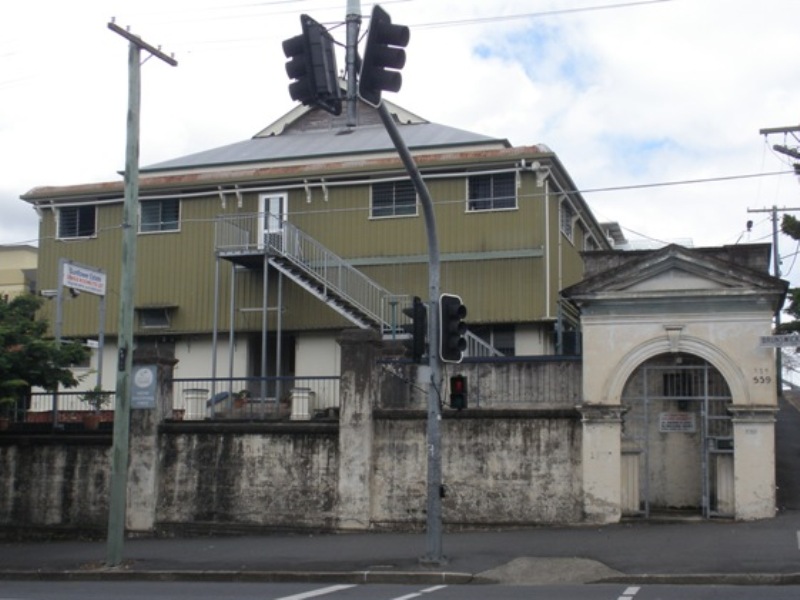Addresses
Type of place
House, Clinic
Period
Federation 1890-1914
Style
Queen Anne
Addresses
Type of place
House, Clinic
Period
Federation 1890-1914
Style
Queen Anne
‘Ermabrae’ was built circa 1903 for Margaret and Ernest Kerr-Scott. As Ernest was a practising GP, the house also operated as a doctor’s office and included a waiting room and surgery on the ground floor. In 1951, after the Kerr-Scott’s had sold the property, the land was subdivided and the residence converted for use as a boarding house. It was particularly common for large houses in inner-city areas to be converted to multiple-dwellings in the 1950s and 60s as the postwar population boom caused widespread housing shortages. A substantially intact original masonry fence with a corner entry porch also surrounds the property.
Lot plan
L1_RP73570
Key dates
Local Heritage Place Since —
Date of Citation —
Construction
Roof: Corrugated iron;Walls: Timber
People/associations
Dr Ernest Walter Kerr-Scott (Occupant)Criterion for listing
(A) Historical; (B) Rarity; (D) Representative; (E) Aesthetic; (H) Historical associationInteractive mapping
Lot plan
L1_RP73570
Key dates
Local Heritage Place Since —
Date of Citation —
Construction
Roof: Corrugated iron;Walls: Timber
People/associations
Dr Ernest Walter Kerr-Scott (Occupant)Criterion for listing
(A) Historical; (B) Rarity; (D) Representative; (E) Aesthetic; (H) Historical associationInteractive mapping
History
In July 1844, Thomas Adams first purchased the land on which 539 Brunswick would later be built. Initially a four-acre block, it was subsequently subdivided by Adams until William Scarr purchased it in August 1867. Scarr purchased 1 rood 9.25 perches but by April 1869 had added to this amount with a further 23.6 perches.
The son of a magistrate’s clerk, William Scarr emigrated to Queensland with his two brothers Frank and Percy in the early 1860s. He gained employment in July 1861 in the Head Survey Office as a Draftsman with the Professional Staff on an annual salary of 400 pounds. His son William Henry was born in Brisbane in 1870. While attending the Brisbane Grammar School, William won first prize for mechanical drawing in the schools section of the Brisbane Exhibition of 1887. Later he was articled to the architect GHM Addison, spending five years in Addison’s office.
A house was erected on the site circa 1884, with the Queensland Post Office Directories listing Scarr as living there by 1885. In May 1902, the land and house were purchased by Michael Duffy as a wedding gift for his eldest daughter Margaret and her fiance. Margaret Duffy married Ernest Walter Kerr-Scott on 4 June 1902.
While staying he in Scotland, Ernest Scott had met a Mark Kerr and his wife. Becoming firm friends with them, he decided to honour them by adding Kerr to his name. A well-respected GP, devout Methodist and advocate of Prohibition, Kerr-Scott had lived at and operated his practice from nearby 477 Brunswick Street since at least 1900.
The Scarr house (529 Brunswick St) was subsequently demolished or removed circa 1902-03, as the Post Office records reveal no listing during this time. The Kerr-Scott house was constructed 1903-04 and first appears in the directories in 1904 named ‘Ermabrae’ (later as 539). The name originates from the names of the owners, ‘ER’ for Ernest, ‘MA’ for Margaret and ‘BRAE’ (Scottish) for hill.
As ‘Ermabrae’ was a Doctor’s house as well as a place of business, it included a waiting room and surgery on the ground floor. Upper level rooms consisted of bedrooms, a sewing room, dressing room, bathroom and the maid’s areas.
‘Ermabrae’ remained in the possession of the family until August 1945 when it was sold following the death of Margaret Kerr-Scott. It is believed that the purchaser, a Mrs Gertrude Victoria Thomson subdivided the property after the sale to its present size. In 1951, the house was approved for registration as a boarding house. This is its current use with registration for 26 rooms and 28 peoples.
‘Ermabrae’ is highlighted in the Queensland Museum publication “The Queensland House”: A Roof over our Heads”. Photographs of the house in original and present condition are also featured on the museum’s web-site, located in the Evolution and Building Materials sections on the Queensland house. The name ‘Ermabrae’ can still be faintly seen on the entrance gate.
Description
The house is a substantial building on a prominent location on the high side of the street and on a corner site.
The house is a large timber structure with a corrugated iron roof with a street facing decorated gable. Earlier photos show the original wrap-around verandah with its original elegant federation period decorations. Although the verandah is currently enclosed the original features appear to have been maintained underneath.
The later cladding and additions can be removed to reveal the original structure and these alterations should not be considered as grounds against the listing of the site.
The house presents to the street a finely designed, substantial masonry fence with a corner entry porch feature. This fence/retaining wall is in fairly original condition only the inserts between the masonry posts having been replaced.
Statement of significance
Relevant assessment criteria
This is a place of local heritage significance and meets one or more of the local heritage criteria under the Heritage planning scheme policy of the Brisbane City Plan 2014. It is significant because:
References
-
Brisbane City Council, Properties on the Web, website
-
Brisbane City Council, 1946 aerial photographs.
-
Brisbane City Council’s Central Library, local history sheets
-
Department of Natural Resources, Queensland Certificates of title and other records.
-
Notes obtained from Robert Riddel Architects
-
Queensland Post Office Directories
Citation prepared by — Brisbane City Council (page revised September 2020)

